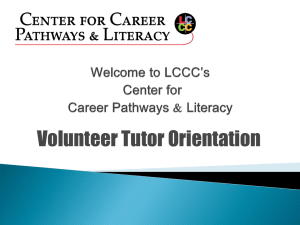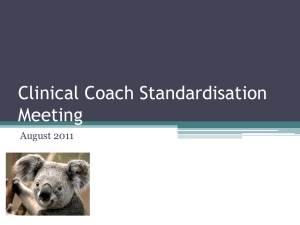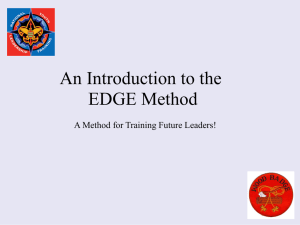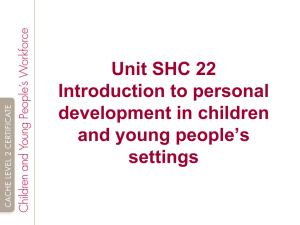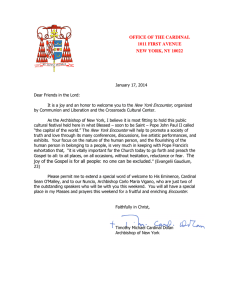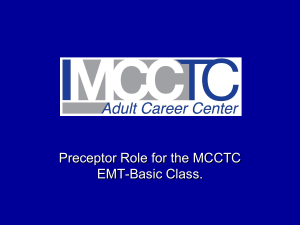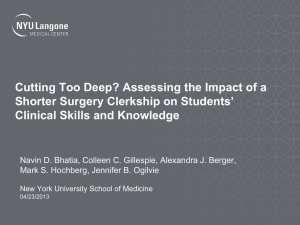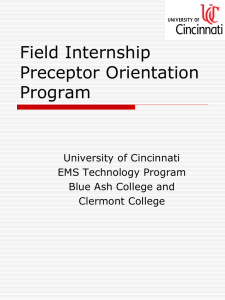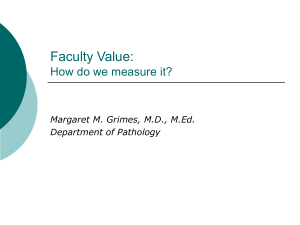file (mime/type)
advertisement
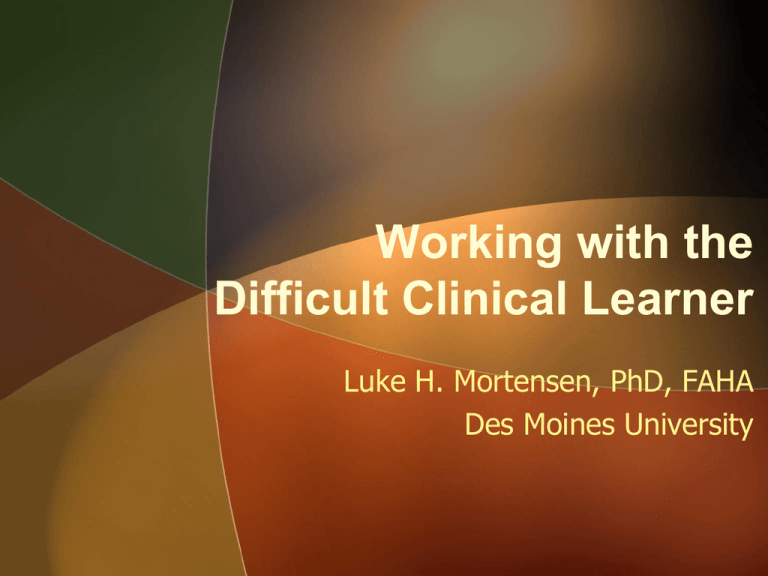
Working with the Difficult Clinical Learner Luke H. Mortensen, PhD, FAHA Des Moines University Why Do You Teach ? It is possible to store the mind with a million facts and still be entirely uneducated. -Alec Bourne Education is the ability to listen to almost anything without losing your temper. -Robert Frost The whole art of teaching is in awakening the natural curiosity of a young mind. -Anatole France What’s Available at DMU? • Cutting-edge technology – METI and Laerdal Human Patient Simulators • Reevaluation of students and clerkship clinical faculty – Computer-savvy students and faculty • Integration of technology into all courses • Medical Informatics Infrastructure – Useful, appropriate and effective communication (electronic and direct) between central campus and all rotation sites Medical Informatics • Introduction to the DMU Portal, e-Library and PDA Resources • Access to the DMU Faculty Development Web-site • Locating and Accessing Full Journal Articles at the DMU e-Library • Evidence-Based Practice Resources • Pub-Med Searching • Drug Resources • Disease Resources/References and Full Texts • PDA Texts, References (ePocrates, etc.), Calculators and Quick Decision e-Books • Differential Diagnosis Tools • Patient Education Resources www.dmu.edu DMU Faculty Development Website Faculty Development at DMU • What is Available (publicly available, structured modules, podcasts, RSS feeds, videos, etc.) – – – – – – – – – – – Evaluation of Learners The Art of Conversation and Conflict Management Leadership and Negotiation Skills in the Clinical Setting Career Goals/Management for Medical School Faculty Understanding a Competency-Based Curriculum Assessing and Evaluating Competency Academic Medicine and Medical Education Research Technology and Teaching Effectiveness Cultural Competency in the Clinical Setting Teaching Medical Students Effectively/Providing Feedback Working with the Difficult Medical Student The “One Minute Preceptor”: Time-Efficient Teaching in a Busy Clinical Practice Teaching the 5-Microskills The “One Minute Preceptor” 10 Minutes of Teaching Time •The average teaching encounter takes 10 min 3 Minutes Questioning 1 Minute Discussion Presentation 6 Minutes – 6 min for the learner to present the case – 3 min for the preceptor to ask questions and clarify information – 1 min of discussion and teaching time •“One Minute Preceptor” model may take more than a minute but provides a structure to help maximize the teaching time of the encounter The 5-Step Microskills Method The One Minute Preceptor strategy is based on five steps that build upon each other: • • • • • Get a Commitment Probe for Supporting Evidence Reinforce What Was Done Well Give Guidance About Errors or Omissions Teach a General Principle Step 1 – Get a Commitment • “What do you think is going on?” • “What do think the plan should be?” • “How should this case be followed up?” • Why?… – It invests the learner further into the case – Encourages learner to process beyond their current comfort level and problem solve – Allows you to assess their problem-solving skills Step 2 – Probe for Supporting Evidence • Explore the basis of the learner’s opinion and what they have committed to in Step 1 – “What factors support your diagnosis?” – “Why did you choose that treatment?” • Why?… – Was it a lucky guess or was it a well-reasoned and logical answer? – Helps you to assess the learner’s… • knowledge base • thinking process • clinical reasoning skills Step 3 – Reinforce What Was Done Well • Skills and positive behaviors need repeated reinforcement to become firmly established – Provide the learner some positive feedback – Increase the likelihood that these behaviors will be incorporated into future clinical encounters • Describe specific behaviors and likely outcomes – “Good job!” is too vague – Example… “I liked that your differential took into account the patient’s age, recent exposures and symptoms…” is reinforcing positive feedback Step 4 – Guide Errors and Omissions • Correct the learner’s mistakes avoiding negative labels such as “bad” or “poor” – Learner less likely to feel judged – Learner more likely to see criticism as constructive • Describe specifically what was wrong, what the consequence might be, and how to correct it for the future – Example… “During the ear exam the patient seemed uncomfortable. Let’s go over holding the otoscope.” Step 5 – Teach a General Principle • An important and challenging task for any learner is to take new information from one encounter and generalize it to others – Manifestation of symptoms – Treatment options – Available resources and references • Why?… Allows learning to be more easily transferred to other situations – Example… “Remember 10-15% people are carriers of strep, which can lead to false positive strep tests.” Conclusion Step • Wrap up the teaching session with directions to the learner about what may be necessary to resolve the case • Why?... – Time management is critical • Signals the end of the interaction so that the learner may move on to the next encounter – Directs remainder of the encounter: • Example…“Let’s go back in the room and I’ll show you how to get a good throat swab. Tell me when we have the results, and I’ll watch you go over the treatment plan.” Example Teacher-Learner Encounter The One Minute Preceptor strategy is based on five steps that build upon each other: • • • • • Get a Commitment Probe for Supporting Evidence Reinforce What Was Done Well Give Guidance About Errors or Omissions Teach a General Principle Difficult Learner “Hard to define… …but you know one when you see one!” – a continuum of struggling failing – deficiencies in one or more areas • • • • • insufficient knowledge poor clinical judgment/reasoning skills poor communication/interpersonal skills professionalism inefficient use of time Objective Structured Educational Experience • The “OSEE” is a simulation of “the difficult learner” as a formative experience for clinical teaching • There exist many useful taxonomies for both the difficult learner and teaching approaches – in this exercise, we will focus on the interactive features of the student-preceptor encounter • As such, this isn’t about doing teaching wrongly or rightly, but to help us reflect on what we are doing as educator-clinicians and teaching efficacy The Scenario • The agenda for today is to start with a volunteer from the audience who will ‘precept’ our “difficult learner.” • The student: – A fourth-year undergraduate medical student – Has just had a 15-minute patient encounter • The volunteer: – Will act as the attending in a clinical environment in which students or residents are seeing patients – Will debrief the student-patient encounter Observation • Following the encounter, we will open the discussion to these areas: – The Encounter • The teaching-learning interaction – Formative Assessment • Feedback for the preceptor – Appreciative Inquiry • Objective is NOT to correct but to explore reasons for choices made Observation of The Teacher-Learner Encounter Debriefing the Encounter… • What did we just see? • Discuss a key point in the interaction that you felt was remarkable. • How would you characterize the learner? • How would you describe the teacher? • How did the preceptor teach this learner? Debriefing the Encounter… • Did the preceptor fall into the learner’s trap by providing answers to all questions asked? • Did the preceptor placate the learner? • What kind of teacher does this learner need? – What do you think the student learned? • What does this learner need from this teacher? – How much time did they take? – How much time do they need? Formative Assessment • Debriefing the faculty member – Feedback for the teacher – DMU resources available for clinical educators • Appreciative Inquiry – What was this encounter like for the preceptor? – Why did they make the choices they made? – Would they change anything? • What would follow-up with this learner include? – What were your expectations? – How do you formally evaluate this learner? – How is the learner remediated? Bibliography • An Innovative Program to Augment Community Preceptors' Practice and Teaching Skills. Wilkes, Michael S.; Hoffman, Jerome R.; Usatine, Richard; Academic Medicine, Vol 81(4), Apr 2006. pp. 332-341. • Reliability and Validity of Checklists and Global Ratings by Standardized Students, Trained Raters, and Faculty Raters in an Objective Structured Teaching Exercise (OSTE). Quirk, Mark; Mazor, Kathleen; Haley, Heather-Lyn; Teaching and Learning in Medicine, Vol 17(3), Sum 2005. pp. 202-209. • Giving effective feedback to medical students: a workshop for faculty and house staff. By: Brukner, Halina; Altkorn, Diane L.; Cook, Sandy; Quinn, Michael T.; Mcnabb, Wylie L. • Initial experience with a multi-station objective structured teaching skills evaluation. Prislin, Michael D.; Fitzpatrick, Camille; Giglio, Mark; Academic Medicine, Vol 73(10), Oct 1998. pp. 1116-1118. • Using "Standardized Students" to Teach a Learner-Centered Approach to Ambulatory Precepting.. By: Lesky, Linda G.; Wilkerson, Luann. Academic Medicine, v69 n12 p955-57 Dec 1994. • Enhancing the Effectiveness of One-Minute Preceptor Faculty Development Workshops. By: Bowen, Judith L.; Eckstrom, Elizabeth; Muller, Melinda; Haney, Elizabeth. Teaching & Learning in Medicine, Winter2006, Vol. 18 Issue 1, p35-41 • Microteaching and standardized students support faculty development for clinical teaching. By: Gelula MH. Acad Med2002 Sep ;77(9):941 Remediation References • Cohen GS , Blumberg, P. Investigating whether teachers should be given assessments of students made by previous teachers. Academic Medicine 1991;66:288-89. The authors describe a discussion from problem-solving sessions at the Generalists in Medical Education meetings. They recommend a written institutional policy allowing faculty to communicate about problem students. • Hemmer PA, et al. Internal medicine clerkship directors’ use of and opinions about clerkship examinations. Teach Learn Med 2002;14:229-35. Reports findings of the CDIM survey about exams. 83% use NBME exam. Exam typically counted towards 25% of grade. Retest usually offered once without remediation; remediation required after second failure. • Hemmer PA, Pangaro LN. Natural history of knowledge deficits following clerkships. Acad Med 2002;77:350-53. The authors describe the “prognosis” of failing medicine clerkship exam. 48 students (6%) failing the exam had acceptable clinical evaluations. 8 of 48 students who failed the exam failed on retaking the exam. All 8 students passed on retake after completing the fourth year medicine rotation. Four of the 48 students failed USMLE Step 2. • Kovach RA et al, “Peer assessment of professionalism: A four year experience in the clerkship.” Presentation at CDIM, Nashville, TN, October, 2004. The author describes a well-received program of peer evaluation regarding professionalism at Southern Illinois University. • Lavin B, Pangaro P. Internship ratings as a validity outcome measure for an evaluation system to identify inadequate clerkship performance. Acad Med 1998;73:998-1002. Retrospective cohort analysis showing some correlation between interns with poor evaluations and those who required remediation during medical school. • Lin C, et al. Personal remedial intensive training of one medical student in communication and interview skills. Teach Learn Med 2001;13:232-9. The author describes an extensive, personalized, successful tutorial for a student who required intensive remediation of communication skills between the second and third years of medical school. • Magarian GJ, Campbell SM. A tutorial for students demonstrating adequate skills but inadequate knowledge after completing a medicine clerkship at the Oregon Health Sciences University. Acad Med 1992;67:277-8. The authors describe a detailed, multi-prong approach to remediating students with inadequate knowledge. Remediation References (cont.) • Noel GL. A system for evaluating and counseling marginal students during clinical clerkships. J. Med Ed 1987;62:353-55. The author describes the USUHS process of all clerkship directors meeting to discuss struggling students and identify remediation plans for those who need them. • Papadakis MA, et al. Early detection and evaluation of professionalism deficiencies in medical students: One school's approach. Acad Med 2001;76:1100-06. The author describes University of California-San Francisco’s well-developed program of identifying lapses in professionalism lapses. • Parenti, CM. A process for identifying marginal performers among students in a clerkship. Acad Med 1993;68:575-77. The author describes University of Minnesota’s review process where Medicine Clerkship Committee reviewed all student evaluations with one or more “below expectations” or “unacceptable” mark in any category. Students could be given a passing grade or referred to the Scholastic Standing Committee (SSC). This review increased the number of students referred to the SSC and remediated. • Peng R, et al. Personality and performance of preclinical medical students. Medical Education 1995;29:283-88. A description of personality traits and medical school performance in Malaysia. • Phelan S, et al. Evaluation of the noncognitive traits of medical students.” Acad Med 1993;68: 799-803. The author describes University of New Mexico’s evaluation of seven professionalism traits: reliability and responsibility, maturity, critique, communication skills, honesty and integrity, respect for patients, and chemical dependency or mood disorder. • Segal SS, et al. The academic support program at the University of Michigan School of Medicine. Acad Med 1999;74:383-85. The authors describe a program striving to identify students at risk of academic difficulty early in medical school and help them access resources. • Wear D, et al. Medical students' experience of academic review and promotions committees. Teach Learn Med 2004;16:226-32. A qualitative description of students’ experiences by promotions committees.

